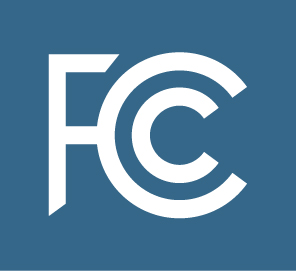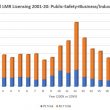LMR licensing sees uptick during first half of year
Land-mobile-radio (LMR) licensing activity during the first half of the year is on pace to result in increases in both the public-safety and business/industrial sectors, which would mark the first time in a decade that both segments of market would see LMR licensing increases, albeit at much lower levels than in 2012.
According to the FCC’s Universal Licensing System (ULS) online database, a total of 1,653 applications were filed with the four approved public-safety spectrum coordinators—1,532 of which have been granted by the FCC—through July 7. If all 121 pending applications were granted, this pace would project to a year-end total of 3,209 applications being approved this year.
If realized, this projection of public-safety licenses would top the totals for each of the last three years and approach the 2018 figure of 3,194. It also would represent the second consecutive year of increased public-safety LMR licensing activity after eight straight years of decreases since 2012, when the FCC granted 10,602 public-safety LMR licenses as users sought to meet the agency’s narrowbanding deadline at the start of 2013.
While any sign of increased licensing is welcomed by the LMR industry, this year’s projected public-safety total would still be one of lowest five figures in the 22-year history of the FCC online ULS database. All five of these lowest totals have been posted during the past five years.
Similar trends are at play in the business/industrial sector, which saw 5.060 applications filed with the FCC through July 7, at which time 4,428 had been granted. If all 632 pending applications were granted, the FCC would be on pace to approve 9.823.9 licenses to enterprise users this year.
This projection would represent an increase when compared to business/industrial LMR licensing activity during the past two years, when the FCC approved between 9,420 and 9,450 spectrum licenses for the sector. Given a normal rate of applications not being granted, the current pace of activity likely would result in 9,500 to 9,600 enterprise spectrum licenses being granted for the year.
As with the public-safety licenses, this projected business/industrial increase in licensing offers some encouragement to the LMR industry, but it does not represent the kind of significant rebound that some had hoped would occur after most COVID-19 restrictions were lifted.
Even with the most optimistic projection, the current pace would result in the third consecutive year of the FCC granting less than 10,000 business/industrial LMR spectrum licenses. It also would mark the sixth consecutive year of the FCC granting less than 11,000 business/industrial licenses—a threshold exceeded in each of the first 16 years of the FCC’s online ULS database.
One positive sign is that current projections would result in year-end increases of LMR licensing activity for both the public-safety and business/industrial sectors for the first time since 2012. However, the projected figures pale in comparison to those of a decade ago, when the FCC narrowbanding deadline was approaching—this year, the combined total of public-safety and business/industrial licenses projects to less than 13,000, while the 2012 combination exceeded 40,000 licenses granted.















